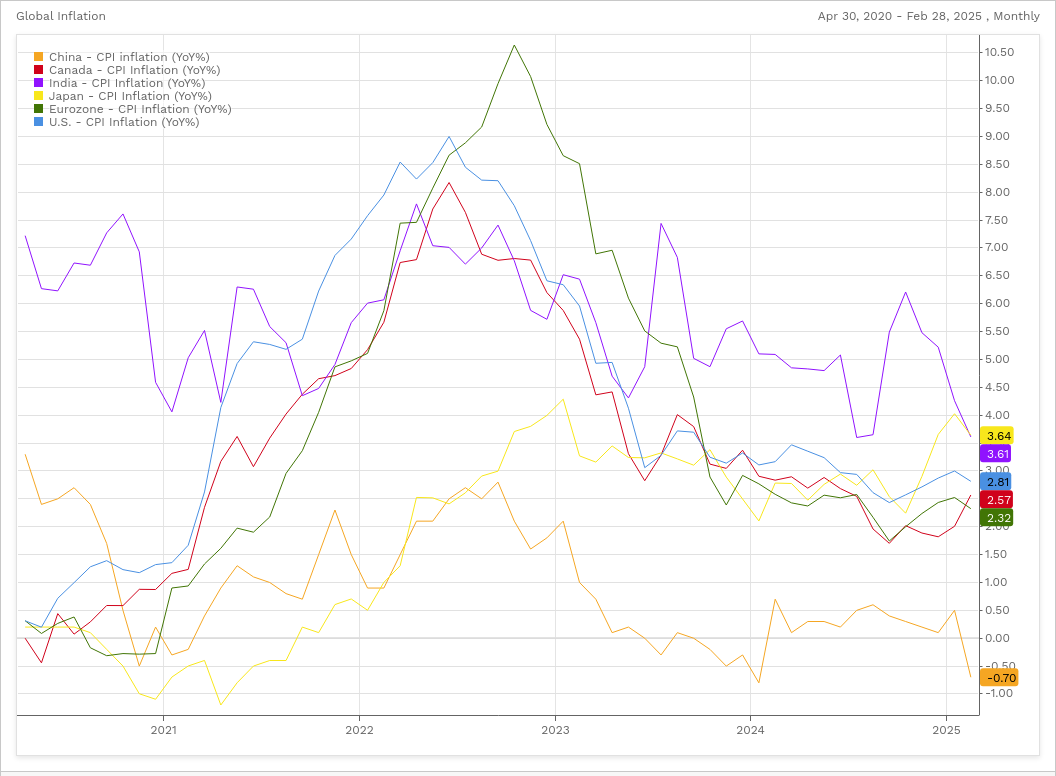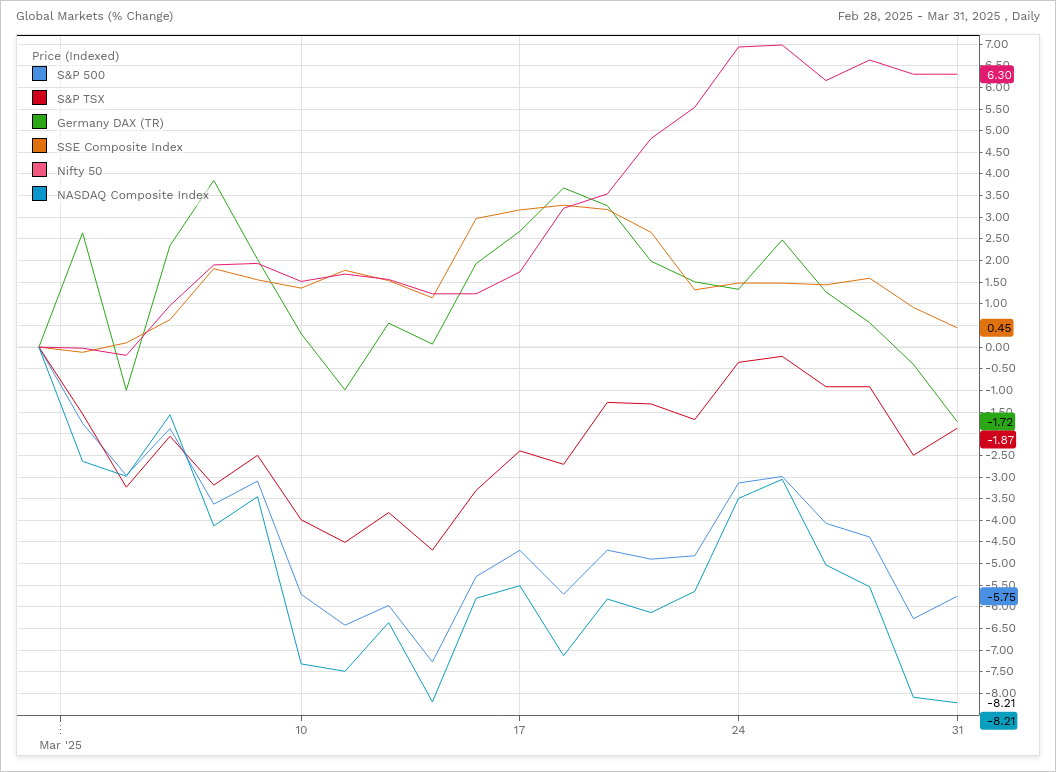Monthly Market Analysis April 2025
Economy
The United States Tariff War
Tariffs on American imports are expected to increase the price of goods for American consumers and cut into the profits of American businesses. Nevertheless, the Trump administration has decided to utilize import tariffs to achieve their priorities:
- Tariffs are being implemented to encourage companies to manufacture their products in the United States. The Trump administration assumes that companies will eventually produce their products in the United States to avoid tariffs.
- The revenue from tariffs will be used to help pay for the extension of expiring tax reduction legislation, which was originally enacted in 2017 during Donald Trump’s first administration. The Congressional Budget Office estimates the cost of extending the 2017 tax cut legislation for ten additional years would be $4.6 Trillion.
- Tariffs on U.S goods are being implemented to help eliminate the American trade deficit with other countries. The U.S. tariffs will be used as leverage to coerce other countries to lower their own tariffs.
- Tariffs are being used as punishment for countries that refuse to carry out American demands.
Newly Announced Trump Tariffs
On April 3rd, the Trump administration implemented a 25% tariff on all automobiles not assembled in the United States.
On April 5th, the United States implemented a 10% baseline tariff on all imports from all countries. In addition to the baseline rates, approximately 60 countries or trading blocs will be tariffed at a higher Reciprocal Tariff rate based on their trade deficit with the United States. All other previously announced tariffs will remain in place and be bundled with the Reciprocal Tariff. For example, Chinese imports, are assigned a 34% Reciprocal Tariff rate, but are also being charged a previously announced 20% tariff, they will now be charged a combined tariff rate of 54%. Canada and Mexico were not impacted by any of the new Reciprocal Tariffs, their goods (except for those covered by the Canada-United States-Mexico Agreement) will be tariffed at a rate of 25%.
All Current Trump Tariffs
• 54% tariff on Chinese goods. China has responded with retaliatory tariffs
• 20% tariff on Eurozone goods.
• 25% tariff on Canadian Goods (Except goods covered under the Canada-United States-Mexico trade agreement). Canada has responded with retaliatory tariffs
• 25% tariff on Mexican Goods (Except goods covered under the Canada-United States-Mexico trade agreement)
• 25% tariff on all steel and aluminum imports into the United States. Canada and the European Union have responded with retaliatory tariffs.
• 10% minimum tariff on all goods imported into the United States. Approximately 60 countries or trading blocs will be tariffed at a rate higher than the base rate. (Begins April 9th)
• 25% tariff on all automobiles not assembled in the United States.
The American Economic Footprint
• The American economy is the world’s largest economy with a size (GDP) of $27.7 Trillion USD7 (estimated by The World Bank).
• China is the world’s second largest economy with a size (GDP) of $18.2 Trillion USD7 (estimated by The World Bank). The Chinese government has responded to the Reciprocal Tariffs by implementing a 34% tariff rate on all U.S. goods imported into China.
• The Eurozone is the world’s third largest economy with a size (GDP) of $15.8 Trillion USD7 (estimated by The World Bank). European leaders are now discussing appropriate retaliatory measures to respond to the new Reciprocal Tariffs levied against European goods.
• Canada is the world’s ninth largest economy with a size (GDP) of $2.14 Trillion USD7 (estimated by The World Bank). Canada has retaliated to the new U.S. Automobile tariffs with a 25% tariff on the non-Canadian components of U.S. made automobiles that are noncompliant with the Canadian-United States-Mexican trade agreement.
How Long will the Trump Tariffs Last?
Although, the U.S. is still considering additional sector specific tariffs, (semiconductor chips and lumber), we are very close to arriving at the maximum tariff rates that the Trump administration will impose on countries around the globe. Please see below for a reminder of conditions in which Trump tariffs will be lowered or eliminated.
- Legal: Trump’s tariffs mostly contravene international trade law, but enforcing these laws can be a long, tedious process often with no enforceable remedies. American industries that are impacted by Trump’s tariffs often have lobby groups that can challenge the legality of the Trump tariffs in U.S. courts. The United States Congress could also intervene, since tariffs are typically under their purview, but Republicans have a majority in Congress and are unlikely to move against their party leader.
- Political Backlash: The negative impact of higher consumer prices in the United States and the unavailability of needed/desired goods due to retaliation by other countries may generate political backlash from U.S. consumers and businesses. China has restricted exports of critical metals to the United States.
- Trade Negotiations: At any time, trade negotiations between the United States and its trading partners around the world could lower or eliminate the newly announced tariffs.
- U.S. Midterm Elections: In 18 months (November 2026) U.S. Congressional Elections may change the political environment. If American voters are unhappy with how the Trump tariffs are impacting their lives, Republicans could lose their majority in Congress.
- Four Year Presidential Term: In less than four years Donald Trump will complete his second and final term as the President of the United States of America. A newly elected American President could undo the Trump tariffs, if they are still in place.
Global Economic Growth & Inflation Rates Before the Trump Trade War
Over the last 12 months ending December 2024, the Canadian economy grew by 2.36%, while the American economy grew by 2.5% (Canada grew faster in the fourth quarter of 2024 with an annualized rate of 2.6% compared to the United States which grew at an annualized rate of 2.4%)
Over the last 12 months ending December 2024, the Eurozone economy grew 1.14%, China’s economy grew 5.4%, India’s economy grew 6.15%, and Japan’s economy grew 1.2%
Global Economic Growth (Annual GDP) Prior to Trump Tariffs – 10 Year Chart

Data provided by FactSet
Global Annual Inflation Rates Prior to Trump Tariffs – 5 Year Chart
At the end of February, the Canadian inflation rate stood at 2.57%, the United States inflation rate was 2.81%, the Eurozone had an inflation rate of 2.32%, China’s inflation rate was -0.7%, Japan’s inflation rate was 3.64% and India’s inflation rate was 3.61%.

Data provided by FactSet
Markets
North American stock markets declined during the month of March as investors panicked about weaker global growth and higher inflation spurred by the Trump tariffs. Last month, the U.S. Market (S&P 500) was down -5.75% while the Canadian market (S&P/TSX Composite Index) was down -1.87%. The U.S. Nasdaq Composite index which contains a high weighting of technology related stocks was down -8.21%. The German stock market (Dax40) declined -1.72%, while the Chinese market (Shanghai Composite Index) increased by 0.45% and the Indian market (Nifty 50 Index) was up 6.3%.
Change in Global Stock Markets March 2025

Now that the Trump administration implemented most of the tariffs they previously announced, market participants will analyze how the tariffs are likely to impact the global economy. Once the initial market selloff passes, investors will attempt to assess the medium-term outlook of the new highly tariffed U.S. economy. Investors will have to consider a possible global economic slowdown, higher consumer prices and lower corporate profits.
Markets should stabilize during the month of April, but likely will not reach their previous peaks unless tariffs end abruptly. Although tariffs are not likely to be eliminated in the short-term, it is highly likely that that we will see lower tariff rates than those announced on April 2nd.
1(Source: Bank of Canada)
2(Source: Statistics Canada)
3(Source: United States Bureau of Labour Statistics)
4(Source: United States Federal Reserve)
5(Source: United States Census Bureau)
6(Source: FactSet as of March 31, 5:00 PM)
 Desmond Rubie, BCom, FCSI®, CIM®, CFP® Wealth Advisor Rubie Wealth Management Group | iA Private Wealth Insurance Advisor | iA Private Wealth Insurance* 26 Wellington Street East, 2nd Floor, Toronto, ON M5E 1S2 T: 647-429-3281 ext. 240018 Desmond.Rubie@iaprivatewealth.ca Schedule a Meeting rubiewealth.com Fellow of CSI (FCSI®) |
*This information has been prepared by Desmond Rubie, BCom, FCSI®, CIM®, CFP®, who is a Wealth Advisor for Rubie Wealth Management Group at iA Private Wealth. Opinions expressed in this article are those of Desmond Rubie, BCom, FCSI®, CIM®, CFP® only and do not necessarily reflect those of iA Private Wealth Inc.
*IA Private Wealth Inc. is a member of the Canadian Investor Protection Fund and the Canadian Investment Regulatory Organization. iA Private Wealth is a trademark and business name under which iA Private Wealth Inc. operates.
*Insurance products are provided through iA Private Wealth Insurance, which is a trade name of PPI Management Inc. Only products and services offered through iA Private Wealth Inc. are covered by the Canadian

Leave a Reply